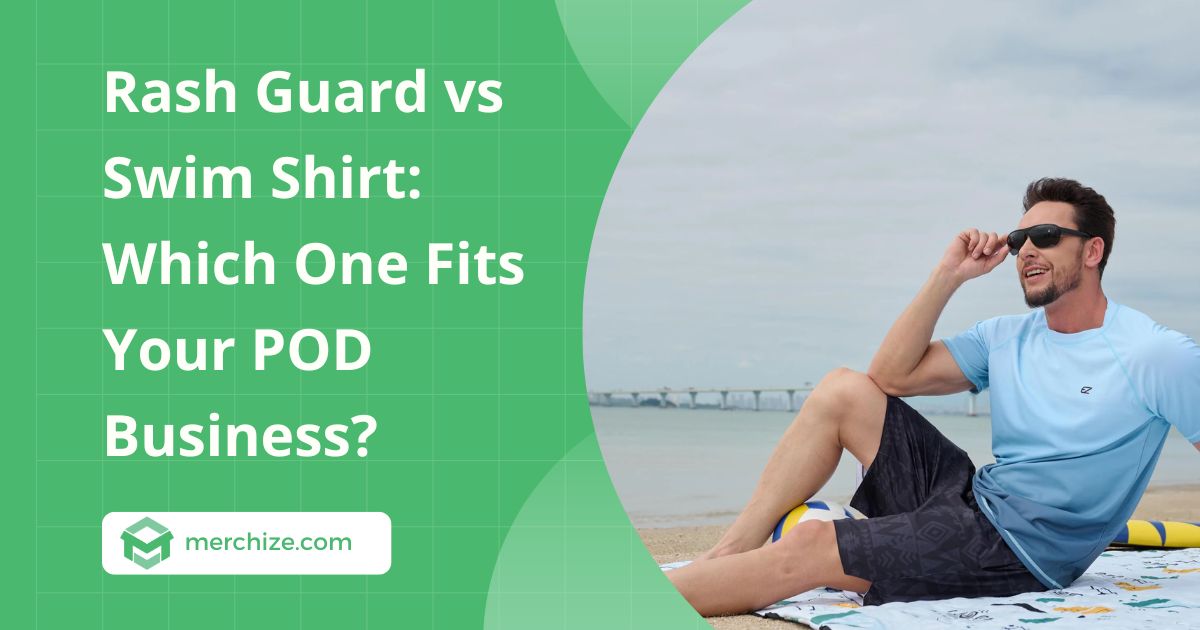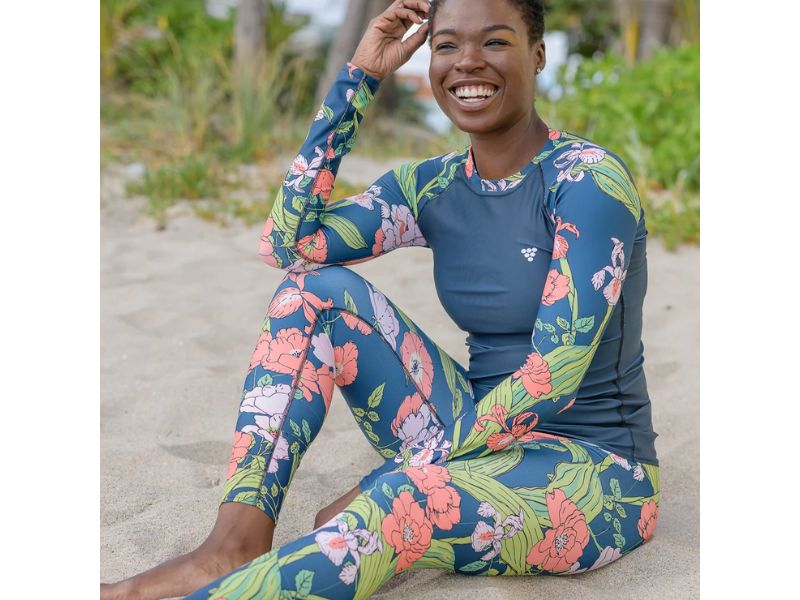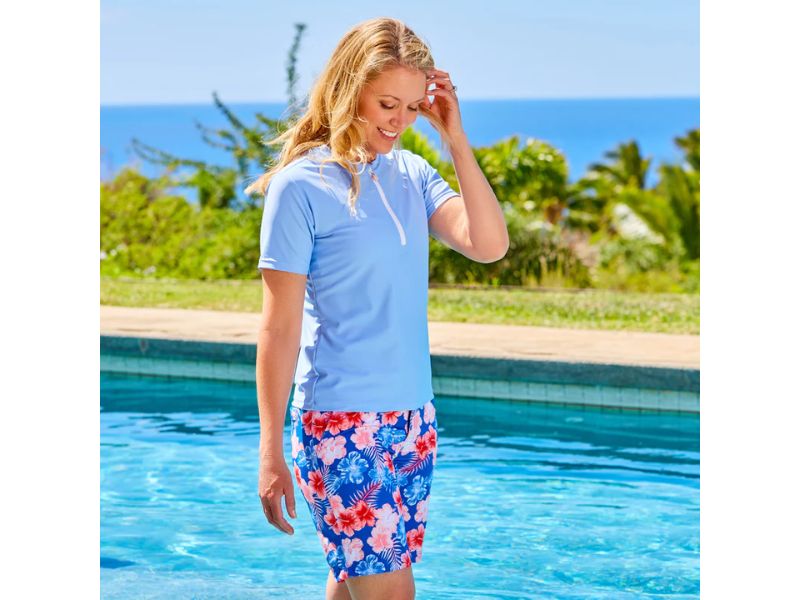Contents
When it comes to swimwear in the print-on-demand world, rash guard vs swim shirt is a comparison that often comes up for many sellers. Both look similar at first glance, but each serves a different purpose and attracts different types of customers. So:
- What’s the real difference between these two?
- Which one are customers searching for more?
- Which sells better and brings higher profits?
- On the season or location, which product should you focus on?
In this article, we’ll break down everything you need to know about rash guards vs swim shirts for you to decide which one truly fits your POD business.
What is a rash guard?
A rash guard is a form-fitting athletic shirt designed to protect your skin from chafing, sunburns, and irritation caused by saltwater or surfboards. Made from stretchable, quick-drying fabrics like polyester and spandex, rash guards are perfect for water sports such as surfing, diving, or paddleboarding.
>> Explore more details at: What Is a Rash Guard Shirt?
What is a swim shirt?
A swim shirt, sometimes called a surf shirt, is designed to give you reliable UV protection that doesn’t wash off in the water. Like rash guards, swim shirts feature smooth, chafe-free seams and quick-drying fabrics for comfort.
Swim shirts have a looser, more casual cut, similar to everyday T-shirts, while still offering UPF 50 sun protection. This relaxed fit makes them more comfortable for light swimming, beach outings, or casual wear by the boardwalk.
Rash guard vs swim shirt: Key similarities
Both rash guards and swim shirts are designed to protect your skin from the sun’s harmful UV rays — one of the leading causes of skin damage and even skin cancer. Most of these garments are made from UPF 50+ fabrics, which provide excellent coverage.
Whether fitted or loose, both types of shirts help minimize sunburn risk and keep you comfortable during outdoor activities. Still, it’s important to remember that sunscreen is recommended for areas not covered by clothing, such as your face, neck, or chest.
In addition, both are popular among print-on-demand swimwear sellers because they’re durable, lightweight, and quick-drying, making them ideal for active and casual beachwear collections alike.
Rash guard vs swim shirt: Key differences
Here’s a quick comparison to help you see the main distinctions at a glance:
| Feature | Rash Guard | Swim Shirt |
| Fit | Tight and form-fitting | Loose and relaxed |
| Purpose | Designed for performance and protection against chafing, UV rays, and board rash | Designed mainly for UV protection and casual comfort |
| Material | Stretchable, quick-drying blend (nylon/spandex) | Lightweight, breathable fabric (polyester) |
| Design | Short or long sleeves, high crew neck, flat seams for comfort | Short or long sleeves, regular T-shirt-style collar |
1. The fit
The most noticeable difference between a swim shirt and a rash guard is how they fit. Rash guards are made for active use: surfing, diving, or other high-intensity water sports, so they fit snugly like a compression shirt.
Swim shirts, on the other hand, are made for comfort and sun protection. They have a looser fit, more like a casual T-shirt. This makes them easier to wear outside the water, whether at a resort, on a family beach trip, or while walking around town.
2. The purpose
A rash guard protects you from both UV rays and skin irritation caused by friction with saltwater or surfboards. Its tight fit keeps the fabric from moving too much during activity — ideal for swimming laps or longer sessions in the ocean.
A swim shirt, meanwhile, focuses mainly on UV protection and comfort. It’s a great choice for light swimming, kayaking, or relaxing at the pool. The looser cut makes it perfect for those who prefer more coverage or want something easy to throw on during outdoor activities.
3. The material
Rash guards are made from stretchable, quick-drying blends like nylon and spandex, offering flexibility and a close fit that moves with your body.
Swim shirts use lightweight, breathable polyester, which feels cooler and more relaxed. The difference in fabric also affects print results for POD — rash guard materials usually hold sublimation prints well, while polyester blends are more versatile for various printing methods.
4. The design
Both come in short- and long-sleeve versions, but the details make the difference. Rash guards typically have a high crew neck and flat seams to prevent chafing during sports. Swim shirts, in contrast, often feature a standard T-shirt-style collar, emphasizing casual wear and comfort.
How POD sellers can maximize profit with rash guards and swim shirts
For swim shirts: Let the fabric speak for itself
The first thing customers notice about a swim shirt is the fabric quality. Invest in materials that naturally communicate value. It can be eco-friendly recycled fabrics, UV-protective fibers, sand-resistant weaves, or quick-dry technology.
When your swimwear feels better, lasts longer, and offers reliable protection, people are more likely to pay a premium for it.
For rash guards: Sell quality and style
Buyers are often willing to pay more for a high-quality rash guard that combines performance with standout design. Focus on creating visually appealing patterns and premium-looking prints that highlight both style and function.
Don’t limit yourself to surf-related niches. Expand your collection to include activewear for hikers, gym enthusiasts, and outdoor adventurers — audiences who value comfort, flexibility, and durability in performance clothing.
Here are some rash guard examples at Merchize:
- All-over Print Short-sleeve Rash Guard
- All-over Print Long Sleeve Rash Guard
- All-over Print Youth Short-sleeve Rash Guard
- All-over Print Women’s Short-sleeve Rash Guard
Expand your swimwear ecosystem
Don’t start your swimwear business with only one type. Think bigger: offer one-piece swimsuits, men’s swim trunks, rash guard sets, or beach accessories like sarongs, cover-ups, and tote bags.
By expanding your product ecosystem, you give customers more reasons to buy from your brand and increase your average order value.
With Merchize’s catalog, expanding your collection is easier than ever
Whether you choose rash guards, swim shirts, or both, success depends on finding the right niche and delivering consistent quality. Pick the product that fits your audience and let Merchize handle the rest.
Here’s why Merchize is a trusted partner for POD sellers:
- Wide product catalog: Merchize offers hundreds of customizable swimwear products
- Global production and shipping: With its main 70,000+ sq.ft factory in Vietnam and fulfillment centers in the US, EU, AU, UK, and China, Merchize ships to over 180 countries worldwide.
- Multi-platform integration: Easily connect your store with Etsy, Shopify, Amazon, eBay, TikTok Shop, Google Shopping, or your own custom API.
- No minimum order quantity (MOQ): Start selling with single orders — no need to buy in bulk or hold inventory.
All you need to do is create and sell. We’ll take care of production, branding, packaging, and global shipping straight to your customers’ doors.
Start selling your custom swimwear with Merchize today!
FAQs
1. What printing method works best for swimwear?
Sublimation printing is the top choice. It produces vivid, long-lasting colors that bond directly with the fabric, perfect for polyester-based materials used in both rash guards and swim shirts.
2. Which product is more profitable to sell?
Rash guards often have a higher profit margin because customers are willing to pay more for performance-grade quality and design. Swim shirts, while simpler, can sell in larger volumes thanks to their everyday appeal.
3. When is the best time to promote swimwear?
The peak season for swimwear runs from spring through summer, especially in markets like North America, Europe, and Australia. However, if you target tropical regions or year-round warm climates, you can maintain consistent sales by adjusting your marketing strategy and design themes throughout the year.
4. Who are the best target customers for rash guards and swim shirts?
Rash guards: appeal to active, sporty customers — surfers, divers, paddleboarders, and gym-goers who value flexibility and UV protection.
Swim shirts: attract casual beach lovers, families, and travelers who prioritize comfort and modest coverage.








